Modernization in cities is meant to ease the commute for workers and offer convenience — to make lives easier. But too often, it’s the poorest urban workers who pay the price for change.
Just after 4 a.m., Lima is asleep, streets nearly empty and sidewalks deserted except for a few women in municipal jumpsuits and masks who clean up debris. Even the densely populated San Juan de Lurigancho district of this sprawling metropolis is quiet.
Then the newspaper vendors — canillitas, they’re called — appear, arriving at the distribution point where they buy the papers they will sell today.
It’s cold this morning and occasionally the mist turns to drizzle. The sidewalk is damp as they get to work, sleeving sections together and bundling the newspapers — a selection of harder news and lighter fare, sports and entertainment. For each paper sold, they will earn 20-25 per cent of the cover price.
It’s just one way a changing world is increasing the daily struggle for some of this capital city’s poorest workers.
But sales of newspapers have dropped precipitously in Lima in recent years, as they have most everywhere, due to the availability of news on the internet. There’s also been a shift among readers in favour of the less serious, sensationalist tabloids. And those cheaper papers offer a lower return to vendors.
It’s just one way a changing world is increasing the daily struggle for some of this capital city’s poorest workers.
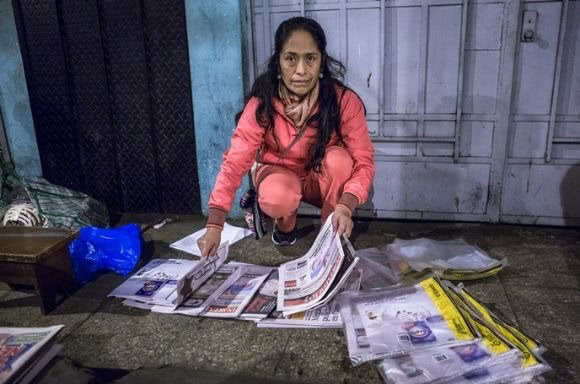
Newspaper vendors: daily challenges before dawn
One of the canillitas on the sidewalk this chilly September morning is Juana Corman Peréz. She takes the weather and the early hour in stride. Like many of these vendors, she’s been doing this work for decades, offering an important service to the public. And like many of her colleagues, she’s unhappy about a lack of support from local authorities in Lima.
Case in point: recently, the newspaper vendors’ union asked about setting up tents to shelter the vendors while they worked. But even though the sidewalks are deserted in these early hours, the municipality refused, saying it would have to charge them to use the public space if they set up shelters.
The municipality refused, saying it would have to charge them to use the public space if they set up shelters.
And then there’s the modern transportation system that’s been established here. This multi-lane road has become a major bus corridor while overhead the Lima Metro, an electric transit system, runs. It’s all designed to offer Lima’s labour force a convenient way to get to work while helping to alleviate the city’s big traffic problems. But modernization has also bisected this community and interrupted the ecosystem of informal livelihoods that used to thrive here. Where once vendors sold tea and food, there are now just these empty sidewalks.
The informal moto-taxis that proliferated on this street have been forced out, too. That’s a particular problem for newspaper vendors, who are not permitted on affordable, modern public transport with their newspapers.
Juana must contract a moto-taxi to pick her up and take her to a small kiosk that is her workplace. The journey, more expensive than before, costs her 7 soles. And that means the first 35-40 units she sells each day — more than a third of her daily turnover — simply pay to cover her transportation.
La Parada’s vendors: moved out to pave the way for “progress”
By 5:30 a.m. the city is awake. As the sun slowly cuts through a gray mist, the traffic begins in earnest. And in the markets, the vendors begin to welcome customers. But like the canillitas, many of these vendors have already put in hours getting ready for the day’s sales.
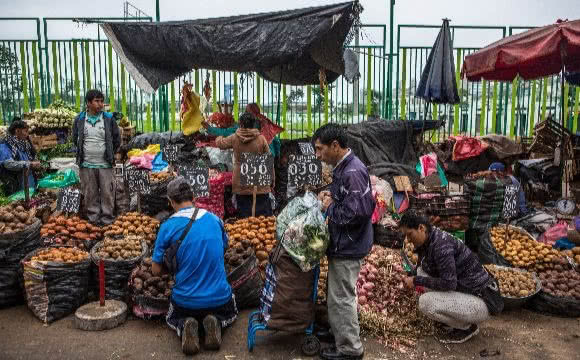
La Parada was, until a handful of years ago, Lima’s main wholesale market. Centrally located, it thrived. About 7,000 vendors made their living here, supported by a well-organized legion of market porters. However, the city decided to build a new wholesale market where wholesalers could rent space. Despite workers' protests, the relocation went ahead in 2012, and sparked violent clashes between vendors and authorities.
Though the wholesale market was relocated to a massive, modern facility at Santa Anita, a smaller number of medium-scale street vendors still operate at La Parada. The problem is, they must go to Santa Anita to acquire their goods. For many, that means waking well before dawn and travelling for hours so they can be ready for their early morning customers.
Where once vendors sold tea and food, there are now just these empty sidewalks.
Meanwhile, the area that had been the wholesale market in La Parada is now a park — the Park of the Migrant — spanning 3.4 hectares. Difficult to access and open only part of the week, locals say it is most often empty, while on its periphery, a busy informal market continues to serve residents and restaurants.
Market vendors: long days and big competitors
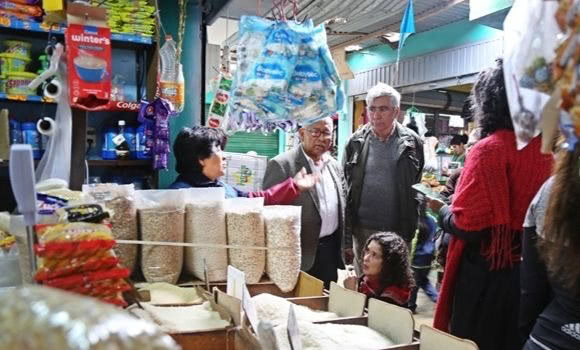
At Mercado Modelo de Pamplona Alta, a retail market, a woman who sells dry goods goes to the wholesale market in the evening, after a long day of selling, to buy inventory for the next day. It’s a dangerous trip after dark, and she worries about the risk because she carries so much money to pay for goods — money that, if stolen, she will have no way to replenish.
She notes that the women and men who sell perishable goods must also travel in darkness to be at the wholesale market by 4 a.m. For some, she says, this can amount to a 150-kilometer round trip through congested Lima traffic. But it’s an essential journey, every day, to ensure their produce is fresh.
But then the city decided to construct a public transportation hub…and the market had to move out.
Freshness matters. Big, modern supermarkets that promise convenience have taken about 30 per cent of revenue out of traditional markets, so these vendors need to offer added value. That’s become a major focus for organizing and mobilizing.
The vendors’ association, The National Federation of Market Workers, is developing strategies to help members compete with gigantic retailers. If traditional market vendors can’t beat the supermarkets on price, they can on quality, freshness and friendly, personal service. And because a lot of workers have come here from rural areas, they provide authentic, traditional food that can’t be found at a supermarket.
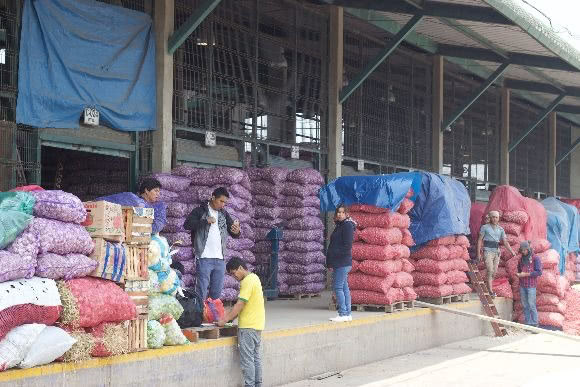
The modern market: a mix of modern efficiency and tradition
Decades ago, Lima’s municipal government hired consultants from the United States to design a plan for a wholesale market in Lima. Mercado Mayorista was finally constructed in Santa Anita in 2012. Today, it turns over 6-7 thousand tonnes of goods daily, which arrive here on about 600 trucks. Whereas at the old facility it took 20 hours to unload the goods, the new facility’s ample space for trucks means the job is done in one-tenth that time.
If traditional market vendors can’t beat the supermarkets on price, they can on quality, freshness and friendly, personal service.
There are a total of about 3,000 workers at the wholesale market, including porters and vendors, and an additional 200 people working in administration. The campus includes a medical center, a pharmacy and a worker facility with showers, lockers and a kitchen. (However, the market manager acknowledges some workers have set up their own, informal facility, because the official one is too small and limits their activity).
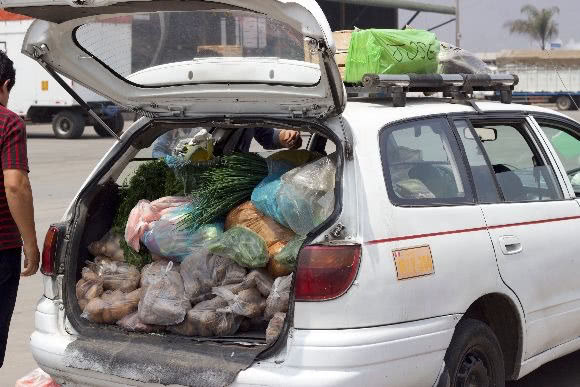
Most buyers must depend on private vehicles to get to Mercado Mayorista and pick up their goods. For small-scale vendors, the journey adds time and expense. A metro link adjacent to the campus is expected to open soon, but that more affordable option also has limitations. Workers are only permitted to carry a small amount of goods onto it — and for traditional vendors in many of Lima’s 300,000 market stalls, small amounts simply don’t give them enough income to survive.
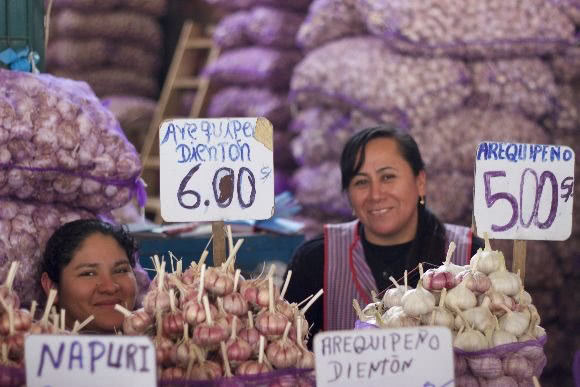
This massive facility may be thoroughly modern, but some traditions hold on. Vendors and porters continue to specialize in certain products. And each product is still said to have its particular patron saint. In the case of onions and garlic, the Virgen de Chapi.
Lima’s informal workers: long days full of challenges.
Juana’s kiosk sits on the corner in a largely residential area. It’s small — three or four people could fit inside, snugly — and the walls are covered with the snack foods and trinkets she also sells. Juana pays 40 soles a year to lease this kiosk from a company; the municipality requires that she maintain a clean four-meter area around it.
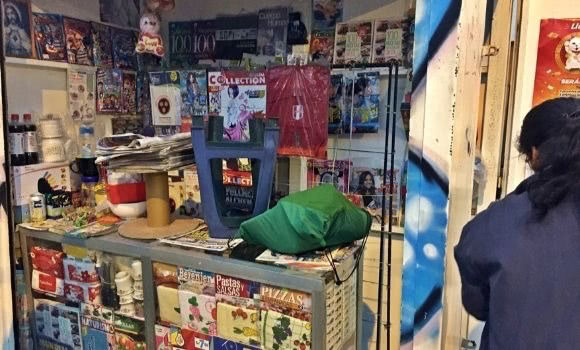
She’ll sell here until 2 p.m. Then, after she closes up the kiosk, Juana will spend hours volunteering with the National Federation of Newspapers, Magazines, and Lottery Vendors (Federación Nacional de Vendedores de Diarios, Revistas y Loterías del Perú, FENVENDRELP), where she helps with legal matters. (Juana recently completed her bachelor’s degree in law. Unfortunately, she doesn’t have money to buy the expensive license required to practice law officially.)
Most buyers depend on private vehicles to get to Mercado Mayorista ... For small-scale vendors, the journey adds time and expense.
One fight that FENVENDRELP has undertaken involves a social protection scheme, of sorts, that had offered limited access to healthcare and pensions to the canillitas. It was put in place in the mid-20th century by industry players and designed without any input from vendors, so it was far from perfect. But it was something, and now it has been frozen for eight years while a criminal investigation looks into allegations of corruption perpetrated by its administrator.
That sort of story, too, seems to be all too common in the modern world.
It will be 9 p.m. before Juana can call her day done and get some rest — though she’ll be up and on the go again long before the crack of dawn.
Para ler este artigo em espanhol, veja aqui.
Feature photo: Papers are prepared for sale while a moto-taxi waits. Photo Leslie Vryenhoek